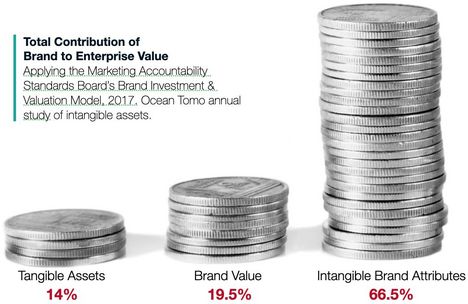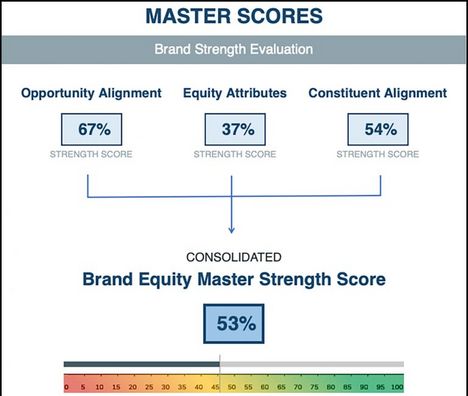Brand Strength Evaluations - The C Suite's Secret Weapon
Oct 11, 2022
A 7-minute read on the power of brand strength evaluations and their ability to drive market performance and increase enterprise value.
For Leadership looking to energize their company, accelerate market performance, and grow equity value and returns, we have your secret weapon. In one sense, it’s always been there. But with increased understanding of the financial return of strong brands and their intangibles, this weapon has never been more powerful.
Brand audits have been around for a long time. However, they’ve traditionally been primarily marketing-focused. No question, brand evaluations or audits are critical for marketers. Assessing a brand’s strengths, weaknesses, and perceptions provide valuable insight and direction for improving market performance. But paying attention to brand strength is not just for marketers; it is an enterprise-wide best practice, and the C-Suite is leveraging this secret weapon not just for marketing but to build sustainable company value.
Building brand equity and the resulting goodwill happens at every point of engagement across all constituents and across the entire enterprise. Evaluating brand strength without considering alignment with stakeholder objectives, business objectives, and market opportunity fall woefully short of adequate. For CEOs looking to accelerate value creation company-wide, 360° Brand Strength Evaluations are your secret weapon. Data shows that a high-performing brand directly impacts overall business performance, revenue, and shareholder value. “Brand” encompasses and impacts all aspects of a business, and so should your brand audit.
A Few Facts
According to the long-time purveyor of intangible asset trends, Ocean Tomo, intangibles now comprise 90% of the value of S&P 500 companies. The single most significant driver of intangible value is brand equity. As reported in Forbes, “Intangible assets are an increasingly vital component of determining corporate worth.” And a brand’s intangible value, while accountants struggle to quantify it on a P&L, drives many proven and documented benefits. Performance benefits and financial benefits. A McKinsey/Interbrand analysis states, “Companies with high brand value consistently deliver a greater total return to shareholders.”

Strong brands realize uncommon customer loyalty, price tolerance, and sustainable success. Strong brands mitigate competitive pressures and market shifts. They increase employee loyalty and productivity, which is important in these times of the Great Resignation. Strong brands own hearts and minds. Yes, brand love is a thing. For private equity, strong brands increase asset value and transaction multiples and can significantly increase investment outcomes. Perceptions and emotions have power. Strong brands always dominate. The Morgan Stanley Capital Index found that the world’s 40 strongest brands yielded almost twice the total return to shareholders over the 20-year period ending in 2019. While it’s easier to quantify in the capital markets, make no mistake, a strong brand accelerates any business, whether B2C or B2B, and for companies of any size. In this, there is no debate.
Alignment Across Constituents and the Enterprise
Building brand strength is always an enterprise-wide endeavor, not just a marketing exercise. Brand is an all-encompassing construct that impacts every aspect of a business and its operation. Brand management is best thought of holistically, as a 360°, always-on proposition. Maximizing equity growth requires unwavering alignment of a brand’s positioning and meaning across all constituents and reinforced with consistency over time.
Your business’s strategic objectives, growth goals, offerings, and market opportunity inform positioning strategy, which then informs brand imaging, meaning, purpose, messaging, and the experiences that deliver the brand experience at every point of touch.
A brand’s positioning and its attributes are reflected in all aspects of operations from employee engagement to customer engagement to user experience, to product development. Positioning defines the place in the market where a company can achieve stakeholder/business objectives and realize sustainable growth. Positioning, combined with a brand’s image, personality, and presence, are the strategic guide rails that define all things.
Business performance and returns are optimized when all aspects of a company’s brand are succinctly articulated, aligned, understood across all constituents, and reinforced consistently over time. This is how brand equity is built It’s how goodwill grows and how all the benefits of a strong brand take root.

Thinking of brand in this context makes clear that brand is more than a marketing concern. Rather it is a leadership issue that requires ongoing management and maintenance. Considers building brand strength as a required cost of doing business, not a discretionary line item that can be whacked in times of tight cash flow. It is a fundamental operating principle for building sustainable success. And it pays serious dividends.
The Brand Strength Evaluation – A 360° Approach
A thorough brand evaluation must do a few things well. It must assess brand attribute strengths and weaknesses across all aspects of the business, internally and externally, with a 360° approach. It must deliver actionable findings that align with stakeholder objectives, business goals, and market dynamics. It must be executed with objectivity and neutrality that can only be delivered by seasoned brand and business strategists with no category or confirmation biases. Most importantly, the data is only good if it is applied to actionable strategies and tactics. Findings and recommendations must be actionable. And, of course, it must be cost-effective, efficient, and non-disruptive to the organization. Demand this of any brand evaluation.
We do this using a proprietary and comprehensive cloud-based evaluation platform that facilitates assessment at a granular level of an exhaustive array of attributes across the three value pillars found in all high-performing and high-value brands.

1. Market Opportunity Alignment
Market opportunity alignment scores the strengths or weaknesses of a brand’s current positioning (target audience, market context, primary benefits/point of difference, and primary proof/support) with perceptions in the market and how well a brand’s positioning attributes align with market dynamics and trends, and the competitive environment. Assessing market alignment strength evaluates and indexes 26 sortable attributes that collapse into an aggregate Market Opportunity Alignment Strength score.
2. Equity Attribute Strength
Equity Attribute scores a comprehensive and sortable set of tangible and intangible brand attributes—significant drivers of brand equity and value. Assessments and scoring are done in three parts. Part one evaluates brand attributes strength internally across seven attributes among leadership, management, and employees. Part two evaluates and indexes 14 intangible brand attributes and their relative alignment and strength to brand objectives, company strategy, and market opportunity. Finally, part three evaluates the brand’s positioning, product or service strengths or weaknesses across 14 drivers that support sustainable performance in the market, attributes that directly impact the sales funnel, loyalty, advocacy, and ongoing revenue.
Attribute scores for the three parts consolidate into three aggregate scores – internal, external, and market strength, then further collapse to a single aggregated Equity Attribute Strength score.
3. Constituent Alignment Strength
We evaluate constituent alignment strength in two parts. Part one evaluates the strength of constituent alignment around brand meaning and understanding, critical for all high-performing brands. Is everyone marching to the same drummer? Alignment is evaluated across Stakeholders, Management, Employees, and Customers. Part one scores alignment across 13 categories of a company’s core brand positioning attributes and the strength or weakness of alignment across key constituents. The scoring identifies gaps in alignment revealing areas of concern requiring increased alignment and understanding of positioning. Part two looks at the alignment of the brand/company’s positioning across four additional categories between stakeholders or the board, leadership, and management to identify gaps in the alignment regarding overall business goals and objectives. Constituent Alignment scores collapse to aggregate scores among constituents group, which then consolidate further into a total Positioning Alignment Strength score.
Each brand pillar is scored and indexed across all its individual attributes and collapse down into aggregate scores to simplify the findings and provide easy benchmarking of results. Aggregate scores for the three pillars then collapse into a Master Equity Strength Scores.

The resulting findings provide the granularity needed to inform recommended strategies and tactics for growth and development opportunities as well as reveal the need for corrective business strategies and opportunities to accelerate performance. Consistency over time is the key to building equity and value. An audit done on a bi-annual basis is an excellent benchmarking and maintenance tool. It also is valuable for annual planning, prioritizing spend, and budgeting. Committing to your brand positioning and brand image without wavering, aligned at all points of brand touch, is the key to building long-term financial value and building sustainable equity.
Actionable Results
And a final thought. Brand evaluations are best not done internally to eliminate confirmation biases and other barriers to objectivity. Instead, leverage seasoned, category-diverse brand and business strategists with careers around building and positioning brands. While research is critical in the process, primary research (expensive and time-consuming) is often not required. Strategic and creative brand evaluations are not a job for researchers. It is a job for strategists who know how to translate findings into actual execution. True, the evaluation criteria are complex and done with rigor, but the end objective is to deliver simple, actionable strategies and tactics that can be implemented on budget and within acceptable scope.
The goal is to move the needle. Brand strength evaluations executed with this holistic, enterprise-wide mindset are a critical best practice and indeed the C-Suite’s secret weapon.
***
Rant, pontificate, agree or disagree, but please do opine. We’d love to hear your thoughts. If you found the article read-worthy, we’d be grateful for a like, and please share it with your community.
About the Author: Lysle C. Wickersham leverages his background in both advertising/branding and investment banking as co-founder of BRANDThink , a strategic brand and management consultancy supporting general businesses, agencies, and PE/VCs in amplifying value creation and brand strategies to build high-performing and high-value businesses. Lysle on LinkedIn . BRANDThink on LinkedIn .
#brandthink #branding #management #creativity #entrepreneurship #marketing #startups #technology #leadership #advertising #privateequity #venturecapital #brandaudits #brandevaluations #growth
Driving both value and performance is an enterprise-wide endeavor. Brand strength is built at every point of touch and engagement. CEOs looking to accelerate value creation and sustainable success understand this. A holistic brand evaluation is their secret weapon.







